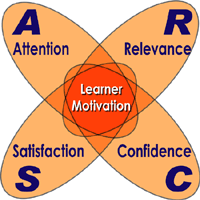Unit 1 Building and Sustaining Community Online
Student Motivation to Engage With and Complete Courses
For learning to take place, students need to be motivated to engage in the work of the class. One of the principal jobs of an educator is to create learning environments that encourage student motivation. Motivation, at the heart of learning, requires our attention regardless of our approach to delivery (online, blended, or in-person).
And we don’t want to confuse student engagement with student’s ability to manage themselves.
“The students who are the best at navigating distance learning environments are not necessarily the most tech-savvy. Instead, they are the most self-directed. They are the students who have developed the soft skills needed to be self-starters and self-managers. These students engage in project management and time management. They problem-solve when tasks get challenging. They find necessary scaffolds when they need help, and they engage in meaningful peer collaboration. These students are constantly engaging in peer and self-assessment.”
Spencer, J. (2020) The Real Issue Isn’t Student Engagement[1]
Assigning good grades to those who perform well is one approach to motivation, tapping into our learners’ extrinsic motivation by rewarding their behaviour with external rewards. But when we tap into our learners’ intrinsic motivation drivers, the results are more effective. When we tap into our learners’ internal need for autonomy (choosing pathways and behaviours), competence (succeeding at existing tasks and mastering new skills) and relatedness (connecting with others socially), we respect the drive for self-determination and self-direction (Ryan and Deci, 2020).
Getting out of the way of student’s desire to learn
Despite our best intentions, we may do things while we are facilitating a course, or have inadvertently built issues into the design of our online courses’ elements that get in the way of our students’ desire to learn. You might see some students stop participating in discussions or missing assignments. As we first discussed at the beginning of this unit, students must juggle their life and study responsibilities, learn to manage their time, and stay on track with their course. We can help them by building elements into our course design and using teaching techniques that are flexible enough to accommodate their challenges while at the same time keeping them engaged.
But when we, for example, dump large amounts of content on them (creating cognitive overload), without giving them sufficient time to interact with the material, nor with you, nor with other students, or when we give them online activities that do not seem to have meaning or urgency, especially in terms of getting better grades, we start to inhibit their motivation for completing our courses. We de-motivate them.
What is Required to Motivate Learners
Let’s look at what is required to motivate learners. The role of the online facilitator, as content expert and motivational coach, is directly connected to student success. Facilitation and motivation may, depending on the context, seem easier to accomplish in a face-to-face environment.
John Keller[2] delineated the motivational elements of instruction as encompassing four necessary components:
- engaging and maintaining student interests,
- relating course content to student interests,
- enhancing student confidence in understanding course content, and
- satisfying students’ inquisitiveness related to information thus encouraging students’ active involvement in learning.
These elements are summarized as (A) attention, (R) relevance, (C) confidence, and (S) satisfaction in order to create the “ARCS Model of Motivation”.

Attention
Attention has to be aroused and sustained for students to really engage in your course. What are some ways you can pique your students’ curiosity or get them excited when at a distance? Varying the elements of instruction and using surprising or less predictable teaching strategies can be a fun way to gain their attention. Stimulate information seeking by posing questions or problems to solve, or have students pose them.
Relevance
If the learner believes the training is not relevant to them, then efforts regarding attention will be wasted. Make sure you let the learner know what’s in it for them. Don’t assume students perceive value. One way to address this is to make clear the relevance of your course by exploring why it matters. We discussed, and you practiced, writing outcomes during your time in the Instructional Skills Workshop (ISW). These outcomes are part of the learning equation, but providing contextual benefit to achieve these outcomes is also required. Keep in mind that this might be different for one learner than it will be for another.
Confidence
This aspect is important to nurture so that students feel positive about putting a good faith effort into your course. Help students develop a sense of competence. Foster motivation by giving students wins and a sense of progress throughout their studies. If you leave them with the impression that they will not be successful, their motivation will decrease. By giving students estimates of the time required to complete lessons, or a measure of their progress at frequent intervals throughout the course, their ability to succeed and their incremental achievements can be gauged.
Satisfaction
The final piece is a learner’s satisfaction or reward from the learning experience. This can be a sense of achievement, whether it is a learner’s high score, a completion certificate, or simply a praise email from you. Ultimately, the best way for learners to achieve satisfaction is to connect new skills/achievements to their benefit.
These four elements of the ARCS model of motivation are relevant regardless of your classroom environment (face-to-face or virtual). Thinking about your own teaching, what techniques have you used, or will you use, that fit within each category?

